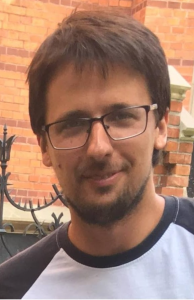BioMaths Colloquium Series – 2023/24
7 February 2024 – 1pm
Join us at 12:45 for coffee tea and biscuits
Board Room 401 (Computational Foundry, Bay Campus) or Zoom (register here)
Dr Jakub Köry
(School of Mathematics and Statistics, University of Glasgow)
Discrete-to-continuum models for mechanics of crosslinked protein networks

Jakub Köry is an applied mathematician working on formulation of multiscale problems arising primarily from biology and medicine. He analyses these problems using a blend of numerical (finite difference or finite element method) and analytical (asymptotic homogenization, discrete-to-continuum upscaling, boundary layer analysis) tools. From 2013 to 2017, he worked on models of plant water and nutrient uptake and obtained a PhD in applied mathematics (2018) from the University of Nottingham, UK. Subsequently, he was a postdoc at the University of Oxford, UK, developing models of blood and oxygen transport through vascular networks (2017-2018). He stayed at Oxford to work on optimizing the efficiency of deformable filter media (2018-2019). Since 2020, he has been working within the SofTMech group at the University of Glasgow, UK, on discrete and continuum models for mechanical response of intra- and extra-cellular protein networks subjected to various external loadings.
Abstract:
Crosslinked protein networks are ubiquitous in living systems, as they confer mechanical stability on both cells and tissues. Existing mechanical models fall into two categories: discrete models enable inclusion of detailed biophysics but are typically computationally challenging due to the large number of discrete elements and their interactions, while continuum models are easier to solve but the manner in which microscale parameters and processes manifest themselves at the macroscale is usually unclear. Modelling efforts involving more rational mathematical methods to systematically bridge between these two approaches are still largely missing. Assuming that two separate length scales exist, discrete-to-continuum asymptotics allows one to upscale local force balance equations using Taylor expansions and form a continuum system of governing equations, inferring the corresponding macroscopic stress tensor and strain energy density. In this talk, we develop and utilize such multiscale mechanical frameworks in two simple settings involving intra- and extra-cellular networks composed of elements exhibiting resistance to axial strains and numerically demonstrate the convergence of the discrete model predictions to their continuum counterparts.
Disregarding dissipative aspects of cellular biorheology, we first estimate forces exerted on a small circular object transported through an initially regular (square) array of pre-stretched protein filaments (e.g. actin, vimentin). We linearize the derived continuum model to construct analytical approximations for the stress and strain fields in the neighbourhood of the moving object, and explicitly compute the net force required to generate a given deformation, which is shown to increase with increasing pre-stress and object size.
We then consider a planar slice of human corneal tissue, represented by a regular network of structural elements mimicking collagen lamellae connected by proteoglycan crosslinks. To simulate the progression of the degenerative disease known as keratoconus, characterized by a large bulging of the cornea, we assign a spatial distribution of damage (i.e., reduction of the stiffness) to the structural elements. We show that a large reduction in the element stiffness results in substantial corneal thinning and a strongly conical shape of the cornea.
